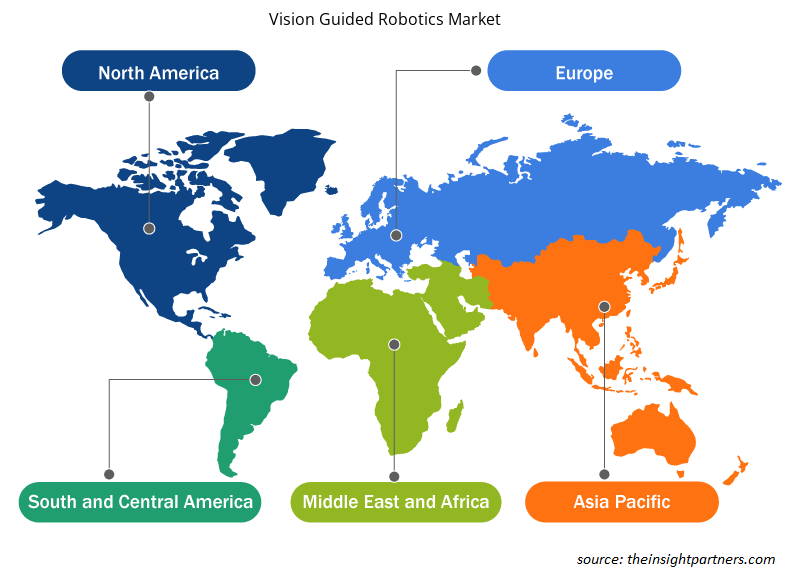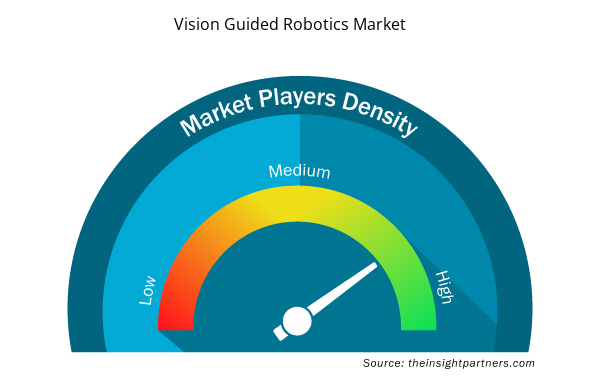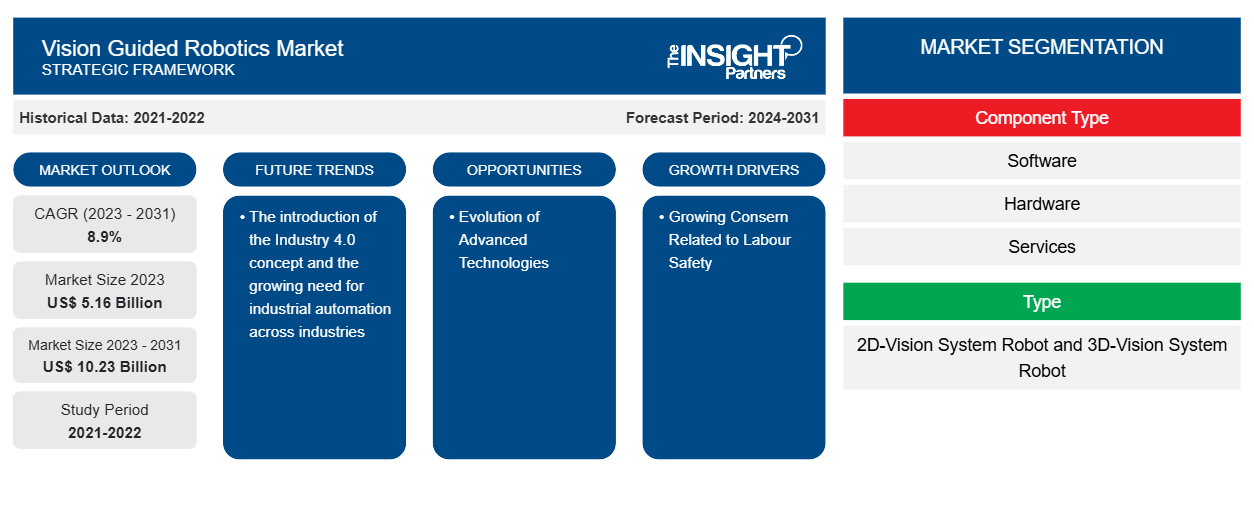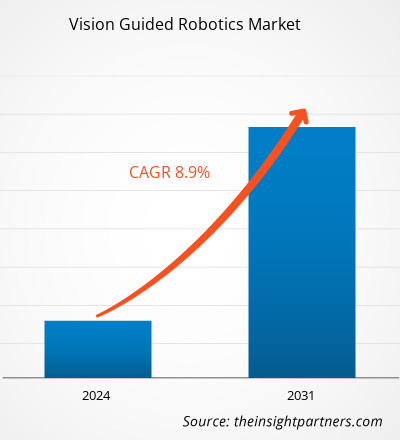ビジョン誘導ロボット市場の規模は、2023 年の 51 億 6,000 万米ドルから 2031 年には 102 億 3,000 万米ドルに達すると予測されています。市場は 2023 年から 2031 年にかけて 8.9% の CAGR を記録すると予想されています。インダストリー 4.0 コンセプトの導入と、業界全体にわたる産業オートメーションのニーズの高まりは、ビジョン誘導ロボット市場の重要なトレンドであり続けると思われます。
視覚誘導ロボット市場分析
視覚誘導ロボット市場は、労働安全に関する懸念の高まり、業界における品質検査と管理の需要の増加、中小企業における視覚誘導ロボットの導入の増加により、急速に成長しています。市場は、協働型製造現場での協働ロボットの使用増加に牽引され、着実に拡大しています。さらに、高度な技術の進化とマシンビジョン技術の開発により、市場の成長に有利な機会が生まれています。
ビジョンガイドロボット市場の概要
ビジョン ガイド ロボットは、コンピューター ビジョン アルゴリズムとカメラを使用して、ロボットが視覚認識と解釈を必要とするタスクを実行できるようにするロボット システムです。ビジョン ガイド ロボットの背後にある基本的な考え方は、ロボットに周囲を見て理解する能力を与え、ロボットが移動し、物と対話し、より正確かつ効率的にタスクを実行できるようにすることです。ビジョン ガイド ロボットは、多くの場合、高解像度カメラ、最新の画像処理、機械学習アルゴリズムを使用して視覚データを評価し、それに基づいて判断を下します。ビジョン ガイド ロボットは、ピックアンドプレース アクティビティ、組み立てと検査、パッケージング、品質管理によく使用されます。自動車、航空宇宙および防衛、食品および飲料、電気および電子、ヘルスケアおよび製薬、金属加工など、多くの業界でビジョン ガイド ロボットの採用が増えており、市場を牽引しています。
要件に合わせてレポートをカスタマイズする
このレポートの一部、国レベルの分析、Excelデータパックなど、あらゆるレポートを無料でカスタマイズできます。また、スタートアップや大学向けのお得なオファーや割引もご利用いただけます。
- このレポートの主要な市場動向を入手してください。この無料サンプルには、市場動向から見積もりや予測に至るまでのデータ分析が含まれます。
ビジョン誘導ロボット市場の推進要因と機会
労働安全に関する懸念の高まりが市場を牽引
国際的な労働安全要件が厳格化するにつれ、世界中の産業界は、危険な場所での人間の労働者の代わりとしてロボットを採用する傾向にシフトしています。ロボットは人間にとって危険で危険な作業を実行できるため、過酷な地形での作業や危険物質の管理など、危険な場所での需要が高まっています。産業界はリスクを軽減でき、特定の危険な環境でロボットを使用することで職場の事故件数が予測期間中にビジョン誘導ロボット市場を活性化させます。
先進技術の進化 – 視覚誘導ロボット市場におけるチャンス
新しい技術の導入により、市場ではより効果的で効率的なロボットが開発されました。これらの技術的に進歩したロボットは、より高い精度と精密さでタスクを実行できるため、コストが削減されます。したがって、予測期間中に市場の成長の機会が生まれます。
技術の進歩により、ロボットシステムはよりコンパクトでモジュール化され、より高品質で多用途なロボットが誕生しました。拡張ロボットやモジュール式ロボットの使用が増えることで、近い将来、市場に大きな成長の機会が生まれます。
ビジョンガイドロボット市場レポートのセグメンテーション分析
ビジョン誘導ロボット市場分析の導出に貢献した主要なセグメントは、コンポーネント タイプ、タイプ、および業界垂直です。
- コンポーネントの種類に基づいて、ビジョン誘導ロボット市場はソフトウェア、ハードウェア、サービスに分かれています。ハードウェアセグメントは2023年に大きな市場シェアを占めました。
- タイプに基づいて、市場は2Dビジョンシステムロボットと3Dビジョンシステムロボットに分類されます。3Dビジョンシステムロボットセグメントは、2023年に大きな市場シェアを占めました。
- 業界別に見ると、市場は自動車、航空宇宙・防衛、食品・飲料、ヘルスケア・医薬品、電気・電子、金属加工、その他に分類されています。自動車部門は2023年に大きな市場シェアを占めました。
視覚誘導ロボット市場シェアの地域別分析
ビジョンガイドロボット市場レポートの地理的範囲は、主に北米、アジア太平洋、ヨーロッパ、中東およびアフリカ、南米/中南米の 5 つの地域に分かれています。
収益面では、アジア太平洋地域が、新興技術と大量の製造能力により、視覚誘導ロボット市場で最大のシェアを占めています。さらに、インダストリー4.0コンセプトの導入拡大と、製造施設の設置に向けた企業からの投資増加により、予測期間を通じて需要が刺激されると予想されます。
ビジョンガイドロボット市場のニュースと最近の動向
視覚誘導ロボット市場は、主要な企業出版物、協会データ、データベースなどの一次調査と二次調査後の定性的および定量的データを収集することで評価されます。以下は、視覚誘導ロボット市場と戦略の動向の一覧です。
- 2023 年 3 月、Smart Vision Lights は、Quality Magazine のウェビナーを共同スポンサーとして開催します。このウェビナーでは、ビジョン ガイド ロボットの最近の進化について取り上げ、新しい自動化ソリューションを探している企業を支援します。このウェビナーは、市場を問わず、企業、品質、工場管理、エンジニアリング、運用など、ビジョン ガイド ロボット技術に関心のあるすべての人に役立ちます。(出典: Smart Vision Lights、プレス リリース、2023 年)
ビジョンガイドロボット市場レポートの対象範囲と成果物
「ビジョンガイドロボット市場規模と予測(2023〜2031年)」レポートでは、以下の分野をカバーする市場の詳細な分析を提供しています。
- 対象範囲に含まれるすべての主要市場セグメントの世界、地域、国レベルでの市場規模と予測
- 市場の動向(推進要因、制約、主要な機会など)
- 今後の主な動向
- 詳細なPEST/ポーターの5つの力とSWOT分析
- 主要な市場動向、主要プレーヤー、規制、最近の市場動向を網羅した世界および地域の市場分析
- 市場集中、ヒートマップ分析、主要プレーヤー、最近の動向を網羅した業界の状況と競争分析
- 詳細な企業プロフィール
レポートの範囲
ビジョンガイドロボット市場地域別洞察
予測期間を通じてビジョンガイドロボット市場に影響を与える地域的な傾向と要因は、Insight Partners のアナリストによって徹底的に説明されています。このセクションでは、北米、ヨーロッパ、アジア太平洋、中東、アフリカ、南米、中米にわたるビジョンガイドロボット市場のセグメントと地理についても説明します。

- ビジョンガイドロボット市場の地域別データを入手
ビジョンガイドロボット市場レポートの範囲
| レポート属性 | 詳細 |
|---|---|
| 2023年の市場規模 | 51億6千万米ドル |
| 2031年までの市場規模 | 102.3億米ドル |
| 世界のCAGR(2023年~2031年) | 8.9% |
| 履歴データ | 2021-2022 |
| 予測期間 | 2024-2031 |
| 対象セグメント | コンポーネントタイプ別
|
| 対象地域と国 | 北米
|
| 市場リーダーと主要企業プロフィール |
|
ビジョンガイドロボット市場のプレーヤー密度:ビジネスダイナミクスへの影響を理解する
ビジョンガイドロボット市場は、消費者の嗜好の変化、技術の進歩、製品の利点に対する認識の高まりなどの要因により、エンドユーザーの需要が高まり、急速に成長しています。需要が高まるにつれて、企業は提供を拡大し、消費者のニーズを満たすために革新し、新たなトレンドを活用し、市場の成長をさらに促進しています。
市場プレーヤー密度とは、特定の市場または業界内で活動している企業または会社の分布を指します。これは、特定の市場スペースに、その市場規模または総市場価値に対してどれだけの競合相手 (市場プレーヤー) が存在するかを示します。
ビジョンガイドロボット市場で事業を展開している主要企業は次のとおりです。
- ABB株式会社
- バスラーAG
- コグネックス
- 株式会社デンソー
- ファナック株式会社
- ISRAビジョン
免責事項:上記の企業は、特定の順序でランク付けされていません。

- ビジョンガイドロボット市場のトップキープレーヤーの概要を入手
- 過去2年間の分析、基準年、CAGRによる予測(7年間)
- PEST分析とSWOT分析
- 市場規模価値/数量 - 世界、地域、国
- 業界と競争環境
- Excel データセット



Report Coverage
Revenue forecast, Company Analysis, Industry landscape, Growth factors, and Trends

Segment Covered
This text is related
to segments covered.

Regional Scope
North America, Europe, Asia Pacific, Middle East & Africa, South & Central America

Country Scope
This text is related
to country scope.
よくある質問
The global vision guided robotics market was estimated to be US$ 5.16 billion in 2023 and is expected to grow at a CAGR of 8.9% during the forecast period 2023 - 2031.
The growing concern related to labor safety, increased demand for quality inspection and control among industries, and rising adoption of vision guided robotics in SMEs are the major factors that propel the global vision guided robotics market.
The introduction of the Industry 4.0 concept and the growing need for industrial automation across industries will play a significant role in the global vision guided robotics market in the coming years.
The key players holding majority shares in the global vision guided robotics market are ABB Ltd., Basler AG, Cognex, Denso Corporation, and Fanuc Corporation.
The global vision guided robotics market is expected to reach US$ 10.23 billion by 2031.
The incremental growth expected to be recorded for the global vision guided robotics market during the forecast period is US$ 5.07 billion.
Trends and growth analysis reports related to Electronics and Semiconductor : READ MORE..
The Insight Partners performs research in 4 major stages: Data Collection & Secondary Research, Primary Research, Data Analysis and Data Triangulation & Final Review.
- Data Collection and Secondary Research:
As a market research and consulting firm operating from a decade, we have published and advised several client across the globe. First step for any study will start with an assessment of currently available data and insights from existing reports. Further, historical and current market information is collected from Investor Presentations, Annual Reports, SEC Filings, etc., and other information related to company’s performance and market positioning are gathered from Paid Databases (Factiva, Hoovers, and Reuters) and various other publications available in public domain.
Several associations trade associates, technical forums, institutes, societies and organization are accessed to gain technical as well as market related insights through their publications such as research papers, blogs and press releases related to the studies are referred to get cues about the market. Further, white papers, journals, magazines, and other news articles published in last 3 years are scrutinized and analyzed to understand the current market trends.
- Primary Research:
The primarily interview analysis comprise of data obtained from industry participants interview and answers to survey questions gathered by in-house primary team.
For primary research, interviews are conducted with industry experts/CEOs/Marketing Managers/VPs/Subject Matter Experts from both demand and supply side to get a 360-degree view of the market. The primary team conducts several interviews based on the complexity of the markets to understand the various market trends and dynamics which makes research more credible and precise.
A typical research interview fulfils the following functions:
- Provides first-hand information on the market size, market trends, growth trends, competitive landscape, and outlook
- Validates and strengthens in-house secondary research findings
- Develops the analysis team’s expertise and market understanding
Primary research involves email interactions and telephone interviews for each market, category, segment, and sub-segment across geographies. The participants who typically take part in such a process include, but are not limited to:
- Industry participants: VPs, business development managers, market intelligence managers and national sales managers
- Outside experts: Valuation experts, research analysts and key opinion leaders specializing in the electronics and semiconductor industry.
Below is the breakup of our primary respondents by company, designation, and region:

Once we receive the confirmation from primary research sources or primary respondents, we finalize the base year market estimation and forecast the data as per the macroeconomic and microeconomic factors assessed during data collection.
- Data Analysis:
Once data is validated through both secondary as well as primary respondents, we finalize the market estimations by hypothesis formulation and factor analysis at regional and country level.
- Macro-Economic Factor Analysis:
We analyse macroeconomic indicators such the gross domestic product (GDP), increase in the demand for goods and services across industries, technological advancement, regional economic growth, governmental policies, the influence of COVID-19, PEST analysis, and other aspects. This analysis aids in setting benchmarks for various nations/regions and approximating market splits. Additionally, the general trend of the aforementioned components aid in determining the market's development possibilities.
- Country Level Data:
Various factors that are especially aligned to the country are taken into account to determine the market size for a certain area and country, including the presence of vendors, such as headquarters and offices, the country's GDP, demand patterns, and industry growth. To comprehend the market dynamics for the nation, a number of growth variables, inhibitors, application areas, and current market trends are researched. The aforementioned elements aid in determining the country's overall market's growth potential.
- Company Profile:
The “Table of Contents” is formulated by listing and analyzing more than 25 - 30 companies operating in the market ecosystem across geographies. However, we profile only 10 companies as a standard practice in our syndicate reports. These 10 companies comprise leading, emerging, and regional players. Nonetheless, our analysis is not restricted to the 10 listed companies, we also analyze other companies present in the market to develop a holistic view and understand the prevailing trends. The “Company Profiles” section in the report covers key facts, business description, products & services, financial information, SWOT analysis, and key developments. The financial information presented is extracted from the annual reports and official documents of the publicly listed companies. Upon collecting the information for the sections of respective companies, we verify them via various primary sources and then compile the data in respective company profiles. The company level information helps us in deriving the base number as well as in forecasting the market size.
- Developing Base Number:
Aggregation of sales statistics (2020-2022) and macro-economic factor, and other secondary and primary research insights are utilized to arrive at base number and related market shares for 2022. The data gaps are identified in this step and relevant market data is analyzed, collected from paid primary interviews or databases. On finalizing the base year market size, forecasts are developed on the basis of macro-economic, industry and market growth factors and company level analysis.
- Data Triangulation and Final Review:
The market findings and base year market size calculations are validated from supply as well as demand side. Demand side validations are based on macro-economic factor analysis and benchmarks for respective regions and countries. In case of supply side validations, revenues of major companies are estimated (in case not available) based on industry benchmark, approximate number of employees, product portfolio, and primary interviews revenues are gathered. Further revenue from target product/service segment is assessed to avoid overshooting of market statistics. In case of heavy deviations between supply and demand side values, all thes steps are repeated to achieve synchronization.
We follow an iterative model, wherein we share our research findings with Subject Matter Experts (SME’s) and Key Opinion Leaders (KOLs) until consensus view of the market is not formulated – this model negates any drastic deviation in the opinions of experts. Only validated and universally acceptable research findings are quoted in our reports.
We have important check points that we use to validate our research findings – which we call – data triangulation, where we validate the information, we generate from secondary sources with primary interviews and then we re-validate with our internal data bases and Subject matter experts. This comprehensive model enables us to deliver high quality, reliable data in shortest possible time.


 このレポートの無料サンプルを入手する
このレポートの無料サンプルを入手する